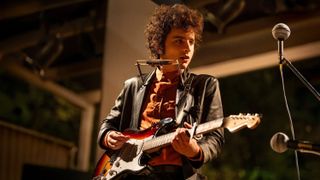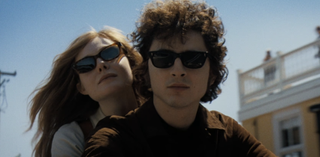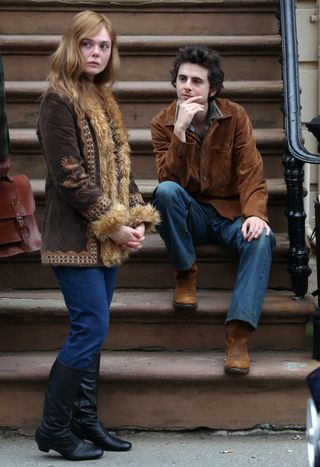Welcome to The Who What Wear Podcast. Think of it as your direct line to the designers, stylists, beauty experts, editors, and tastemakers who are shaping the fashion-and-beauty world. Subscribe to The Who What Wear Podcast on Apple Podcasts and Spotify.
On the latest episode of The Who What Wear Podcast, I'm joined by Arianne Phillips, the costume designer of A Complete Unknown. She told me the backstory behind some of Timothee Chalamet’s 67 costume changes, which required more fittings than she’s ever done for any other movie she’s worked on (including Don’t Worry Darling, Once Upon a Time in Hollywood, and Walk the Line).
Phillips discussed how her costumes reflected Bob Dylan’s style evolution, which went from baggy jeans and workwear shirts in the early '60s to fitted blazers, skinny jeans, and sleek Chelsea boots just a few years later. Phillips also revealed where she sourced Chalamet's sunglasses (Old Focals) and the special jacket worn by Elle Fanning in the film (Etsy). Scroll down for excerpts from the interview.

(Image credit: Courtesy of Searchlight Pictures)
What was your experience working with Timothée Chalamet?
"Being a costume designer, we are the only department that says, 'Hello, nice to meet you. Take your clothes off.' It's a very intimate job, and we're often the first person that the actor meets before shooting. That first day we met, it's really about building trust. And I believe that my job is helping them visually with research. Timmy had been really, really focused with [director James Mangold] on the script, the acting, the singing, and the music—he learned piano, acoustic and electric guitar, and harmonica. So he had his hands full for quite a while. He was a wonderful scene partner for me in terms of his enthusiasm and his sense of focus. We had to do many fittings—I probably did more fittings on this movie than I've ever done because of the way that we were telling this story through time. Working with Timmy was a dream. He's incredibly open and curious, which are always my favorite qualities in an actor. And very, very collaborative. He was really up for everything, and patient. You know, it takes a lot of patience to do fittings. We have to prick and prod and try things that maybe never work. We have to turn over every stone to make sure we're making the right choices."

(Image credit: Courtesy of Searchlight Pictures)
I'd love to talk about Bob Dylan's sunglasses. Can you discuss the symbolism of these accessories and where you sourced them?
"The sunglasses provide a veneer and a separation from the bright lights and the fandom that he was largely uncomfortable with. The sunglasses are Bausch and Lomb, which is a very early iteration of Ray-Ban. There's a wonderful business here in Los Angeles that supplies vintage glasses, optical and sunglasses, called Old Focals. I went to [the owner Russ Campbell] immediately. He knew exactly what sunglasses [Bob Dylan wore]. And we just had to figure out what was right for Timmy’s face.
I really learned a lot about Bob Dylan's style in 1965. When he went to London on tour, he clearly came back with Chelsea boots and skinny jeans. His hair got longer, his sunglasses got more angular. He was a huge fan of The Beatles, and he was hanging out with them and Donovan, and you can see that early mod style that he adopted in 1965. The sunglasses are definitely part of that rock and roll archetype that is so iconic.

(Image credit: Getty Images)
Where did you source the traditional Romanian coat that Elle wears in the film?
"I personally didn't want to use real fur, which Bob probably wouldn't have been able to afford at that time anyway. It took quite a while to source that coat. We got it from a vintage dealer on Etsy. That was one of those gems that we were able to find, but most of Timmy's costumes were made. There are a few vintage pieces that are always important, I think, especially because you just can't recreate the hang and the feel of that fabric and sometimes the patterns."




















 English (US) ·
English (US) ·